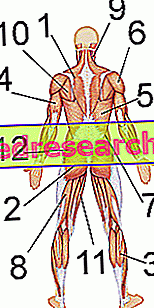Cholecystectomy is the surgical procedure for removing the gallbladder.
Functions of the gallbladder
Better known as a gall bladder, the gallbladder is a pear-shaped organ located just below the liver on the right side of the abdomen. Its task is to collect and store the bile produced by the liver, concentrating and pouring it into the intestine after meals, especially fats, to promote digestive processes.

We invite the reader without in-depth medical knowledge to keep in mind the anatomical reference of the image to the side in order to better understand the technicalities used during the article.
Surgical technique
The elective procedure for the removal of the gallbladder is laparoscopic cholecystectomy, which for many years has largely replaced the open surgical procedure, called open cholecystectomy.
The advantages of the laparoscopic technique are important, both in terms of health costs and in terms of benefits for the patient. Not surprisingly, it is known to be a minimally invasive surgical technique.
Laparoscopic cholecystectomy
PREPARATION
Before the operation, the subject will have to undergo a series of tests to establish physical fitness for laparoscopic cholecystectomy. To this end, blood tests, an abdominal ultrasound, and a general amnestetic evaluation are performed to investigate the patient's clinical history in view of anesthesia and surgery. During the preparatory phase, the doctor will also investigate the possible use of drugs that could be suspended in view of the cholecystectomy. For example, if the subject takes anticoagulants (Coumadin, sintrom) and / or antiplatelet agents (Plavix, Aspirin) it is generally necessary to suspend therapy for 5 to 7 days before the cholecystectomy, replacing them with a suitable low heparin dose molecular weight (enoxaparin or similar).
A couple of days before the laparoscopic cholecystectomy, the execution of a preoperative endoscopic retrograde cholangiopancreatography (see below) may be required, through which localized stones in the common bile duct are searched for and possibly removed.
Prior to surgery, abstaining from drinking and eating for at least 6 hours before surgery is required - unless otherwise prescribed by a doctor; in the days that proceed, intestinal cleansing may also be required using osmotic laxatives. Even personal hygiene is important, so much so that some centers suggest cleansing with special antibacterial soaps.
Before the operation intravenous antibiotics are administered, in order to reduce the risk of infection. Once the patient has been anesthetized, the skin of the abdomen is carefully disinfected with an antiseptic solution: cholecystectomy can then begin. Prophylaxis of deep vein thrombosis can be performed by administering low molecular weight heparin, or using elastic stockings for graduated compression of the lower limbs.
FOR WHOM IS IT INDICATED?
The doctor may decide to perform a laparoscopic cholecystectomy in the presence of gallbladder and biliary tract stones, and / or related complications. In particular, surgery is indicated in the presence of symptomatic gallbladder stones (presence of gall bladder stones accompanied by episodes of biliary colic or other typical symptoms), choledocholithiasis (presence of stones in the common bile duct or bile duct), cholecystitis ( inflammation of the gall bladder with distension of the same by local accumulation of water, mucus - hydrops - and possibly pus - empyema), obstructive pancreatitis (inflammation of the pancreas due to the presence of stones in the choledochus, such as to prevent the correct outflow of pancreatic juice into the intestine ).
WHAT RISKS DO YOU HAVE IN THE CASE YOU DECIDE NOT TO TAKE ANY INTERVENTION?
The risks result in the possibility of a worsening of the symptoms of the underlying pathology for which surgery is recommended. These complications range from the recurrence of biliary colic, jaundice and abdominal pain symptoms, up to real medical emergencies such as gallbladder perforation with peritonitis.
HOW DO YOU DO IT?
The first laparoscopic cholecystectomy was performed in 1987 by Philippe Mouret, in Lyon, France. During the operation, the surgeon makes three or four small incisions, 0.5 to 1 cm in diameter, in the patient's abdomen, which act as a gateway for the insertion of special watertight cannulae (trocar), at in which the small surgical instruments necessary for the operation flow. The operating space for the correct operation of these instruments is created by insufflating carbon dioxide (pneumoperitoneum) with a Veress needle, after a skin incision at the sub-umbilical level. Created the pneumoperitoneum, through the first trocar, the laparoscope is inserted into the abdomen: an instrument equipped with a micro-camera connected to optical fibers and a light source, which allows a visual exploration of the internal abdominal region on the appropriate screen of the operating room.
Under this visual guide from the inside of the abdomen, the other 3 trocars are inserted in the respective incisions. The surgical instruments necessary for the traction, dissection, cutting and removal of the gall bladder, as well as coagulation and irrigation / aspiration flow inside these cannulas: a forceps or a palpator pushes up the liver; a pincer isolates the cystic duct and moves the gall bladder to the most suitable position, dissecting it from the neighboring structures; still using pincers, metal clips are positioned for choking the cystic duct and the cystic artery; finally, a scissor or other instrument operates the resection of the organ. Once the gallbladder is removed, it is then extracted and controlled for bleeding, then the surgical field is washed, the insufflated carbon dioxide is sucked in and the skin incisions are saturated with clips or stitches.
NOTES: The initial isolation of the cystic duct allows you to inject into contrast media to perform a biliary tract x-ray (intraoperative cholangiography) and in this way to highlight any stones inside the common bile duct. If these are present they can be removed, always under guidance laparascopia, in a similar way as seen for cholecystectomy, directly or with the aid of a basket or a balloon. Nevertheless, faced with the suspicion of calculus in the common bile duct, when possible, preoperative endoscopic retrograde cholangiopancreatography is performed for diagnostic and operative purposes, because exploration of the common bile duct during laparoscopic cholecystectomy is difficult. During this operative endoscopy operation, a small flexible tube is made to descend along the esophagus, the stomach and the duodenum up to the point where the choledochus (Vater's papilla) opens, inside which it is channeled to inject contrast media into the common bile duct; by dilating the walls with papillosphincterotomy, the removal of the stones is facilitated by appropriate instruments. Laparoscopic cholecystectomy can be performed two days after removing these calculations.
AFTER THE LAPAROSCOPIC CHOLECISTECTOMY
The operation is performed under general anesthesia. Upon awakening from anesthesia, the patient is returned to his room. He can then start drinking eight hours after surgery and eating lightly the next day. During this time it may be necessary to administer painkillers. Discharge is generally the second or third postoperative day. At the latest within a week - 10 days the patient can resume his normal working life. See also: Diet and Nutrition after Cholecystectomy
RISKS AND COMPLICATIONS
Laparoscopic cholecystectomy is the most performed in the world. For this reason, given the standardization of the procedures, the risk of complications has stabilized on the whole to values lower than one percent. Below is an extract of the information for patients prepared by the general surgery unit of the S. Andrea Hospital in La Spezia, which can be consulted at this link together with the bibliographical references.
Possible risks | What happen | Keep it informed |
| Infections | Infection occurs in less than 1 patient in 1000 undergoing laparoscopic procedures | The rules of asepsis will be respected and the antibiotics will be administered before the intervention |
| Damage to the bile ducts | Operator incidents on the biliary tract are reported in 1 patient in 1000 for open cholecystectomy, and from 1 patient to 5 for laparoscopic surgery. | Healthcare personnel will check for the appearance of jaundice, fever or changes in blood tests. Further testing or further intervention may be necessary |
| Bleeding | Bleeding is rare. If you have chronic liver disease your liver may have coagulation deficiency. | The surgeon will check his coagulation profile for any deficiency. Generally a blood transfusion is not necessary for cholecystectomy. |
| Biliary loss | Biliary loss after surgery is rare | The appearance of fever or alterations in the exams will be checked and you may need other tests, such as ultrasound or endoscopic retrograde cholangiopancreatography (ERCP). |
| Retention of a calculus in the main bile duct | A biliary calculus may be present in the main bile duct at the time of surgery | In this operative unit, intraoperative cholangiography is practiced every time it is possible and often the problem is solved with an intraoperative ERCP |
| Pneumonia | Possible causes are: general anesthesia or lack of deep inhalation or postoperative immobility | Breathing exercises with deep inspirations will help expand the lungs and prevent complications after surgery |
| Heart problems | Heart problems are rare. Cardiac arrhythmias are reported in 5 of 1000 patients, while a heart attack in 1 in 1000 patients | Your surgeon may prescribe a pre-operative cardiology visit. Every anesthesiologist is prepared to face any eventuality |
| Kidney problems | Kidney or urinary problems have been described with a frequency of 5 in 1000 patients. Dehydration and liver disease can increase the risk | You may be given fluids before your surgery. Inform the nursing staff when urinating. |
| Deep vein thrombosis | The absence of movements during surgery can lead to the formation of clots in the legs and rarely these clots can obstruct the pulmonary vessels | Compression bandages in the lower limbs or injections of anticoagulant drugs may be used. It is his duty to stand up and walk after the surgery |
| Intestinal or abdominal organs injuries | The insertion of instruments is the use of monopolar electrocautery can damage the intestine | Your surgeon is trained to minimize these risks and to provide for one of these occurrences. Obese or already undergoing surgery or with intestinal adhesions are more exposed to these risks |
| Death | It is extremely rare in healthy subjects and is reported from 0 to 1 patient per 1000. This risk increases in case of gangrene, gallbladder perforation or severe pathology | All surgical staff are trained to minimize any complication and to prevent them from occurring |
During convalescence, it is advisable to alert the healthcare facility where the intervention was performed if symptoms such as: severe abdominal pain, stomach cramps, high fever or chills, yellowing of the skin (jaundice), infection of the wound (which becomes foul smelling and secreting materials) or major alveolar changes (constipation or diarrhea) that have lasted for more than three days.
Open cholecystectomy
Technique now reserved only for cases in which the laparoscopic procedure is contraindicated, or if complications arise during its execution such as to require the transition to traditional surgery.
In this case, access to the gall bladder is guaranteed by a deep fifteen centimeter incision in the upper right quadrant of the abdomen. Given the invasiveness of the procedure, recovery from surgery is slower, the wound is more prone to being infected and less aesthetically pleasing to the patient. Discharge occurs within 5 days of the operation (compared with 24-72 hours of laparoscopic cholecystectomy) and incision of the abdominal muscles requires a longer period of abstention from physical efforts.



